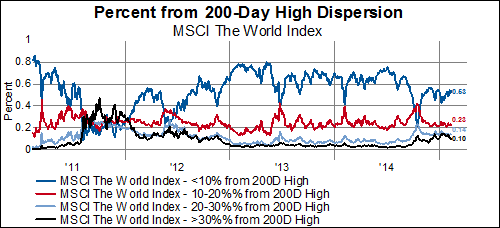Several financial market commentators have recently been making the case for EM Asian stocks based on their valuation level. One of the commonly used charts is the first one below, which shows the forward 12-months price to cash flow valuation for EM Asia relative to North America. By that measure, it sure appears that EM Asia stocks are cheap!
However, when we dig into the details, we come to a considerably different conclusion. In the second chart below we show the forward 12-month (red line) and median (blue line) price to cash flow ratio for MSCI EM Asia. The forward ratio, which also happens to be market cap weighted, looks like it has barely risen off of its 2011 low. Meanwhile, the median ratio - which uses actual results and is by definition equal weighted - is nearing its high level over the last eight years.
So what gives? How can EM Asia stocks be cheap and expensive at the same time? There are three reasons for this:
- When we consider that North American stocks are trading at just about the highest valuation levels one could reasonable expect outside of a mania, pretty much everything looks cheap relative to them.
- The composition of EM Asia is heavily tilted towards capital intensive, sometimes state-owned, inefficient, commodity pass through, "old economy" stocks and financials. Those are the stocks that are cheap. Pretty much everything else - the "new economy" stuff that leverages the emerging EM consumer - is at or near its historic highs.
- Forward valuation ratios use analyst estimates that are typically revised downward as the fiscal year progresses. This means the denominator starts off large and then falls, meaning the valuation level looks cheaper toward the beginning of the estimate period and the eventual realized ratio is higher.
To highlight point number two above, we've shown the median company valuation level for each sector in EM Asia. The median company in Consumer Discretionary, Consumer Staples, Health Care, Industrials, and Information Technology is trading at or near its all-time high for as far back as we have data. Meanwhile, the median stock in the Energy, Financials, Materials, Telecom, and Utilities sectors is either near it's low or at least well off the high.
There may be a case for investing in EM Asia, but valuation does not appear to be one of them unless you want to own banks or commodity pass through plays. Those areas may well be due for a cyclical rerating, but the longer term trends don't appear to be on their side.

































